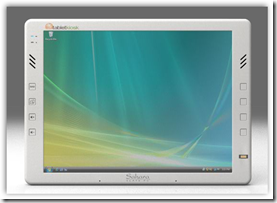Below we have 2 different physicians, one who embraces technology so much to the fact that she has become an technology evangelist to help and convince other physicians to “buy in”, and she works as an emergency ER physician too. The second physician vowed to keep the paper trail going, that is until he embraced voice recognition.
I believe speech recognition is the big key here as the physician can dictate and document with  their own individual interpretations versus slapping in a generic template that may not indicate his/her full interpretation and is a rather formatted series of text that is more a clinical generic description. Templates can be handy too, but rather more so if they are customized to how the individual physician wants to use them, in his/her words and not generic in summary; and the dictation process along with editing can remove and add items that are specific to the patient chart.
their own individual interpretations versus slapping in a generic template that may not indicate his/her full interpretation and is a rather formatted series of text that is more a clinical generic description. Templates can be handy too, but rather more so if they are customized to how the individual physician wants to use them, in his/her words and not generic in summary; and the dictation process along with editing can remove and add items that are specific to the patient chart.
 The second part of the “buy in” process involves management at all levels when it comes to meetings and documentation. I have witnessed physicians bring their Tablet PC into a meeting, and yet the CEO, CIO, CTO, etc. is sitting there with a “yellow paper pad”, so what’s up with this picture? The physician will have even his meeting notes all backed up on a tablet, while the administrative staff themselves are still chunking along with the big yellow pads, so it is a bit of a parody to see top level management using paper methods themselves, but yet telling physicians and other clinical staff how this technology will help them do their jobs.
The second part of the “buy in” process involves management at all levels when it comes to meetings and documentation. I have witnessed physicians bring their Tablet PC into a meeting, and yet the CEO, CIO, CTO, etc. is sitting there with a “yellow paper pad”, so what’s up with this picture? The physician will have even his meeting notes all backed up on a tablet, while the administrative staff themselves are still chunking along with the big yellow pads, so it is a bit of a parody to see top level management using paper methods themselves, but yet telling physicians and other clinical staff how this technology will help them do their jobs.
No wonder the process it taking so much time when we may not have enough at the top of the ladder embracing a bit of technology themselves and setting the pace for both the administrative the clinical staff to try to enhance their production and records with a little technology. Perhaps this could be a new direction here, with top executives themselves setting an example and figure out how they can better use technology too, it certainly could not hurt.
You could almost hear this fit right in to place with a clinician challenging an executive, “Well if mobility, Tablets, and PDA devices along with the related software are so good, why do you keep running around with yellow paper pads for your meetings and administrative notes"?”, and you know that is one good question! Why do top executives who profess and claim technology is the solution, keep running around with paper to do their jobs? Maybe this is a bit of a missing link here, the ultimate “buy in” at the top of the chain of command.
 Shoot this could even be good too as the exchange of how each one uses technology could be educational and helpful too across different levels, besides just peer to peer. I think it’s time that some of the folks at the top perhaps give this a second thought here and see if in fact they have really “bought in” themselves, or just spend a lot of time talking about it. That is somewhat of an interesting picture to paint with all the clinicians on staff showing up with a tablet to take notes, and yet watch the executives still struggle and use those yellow paper pads.
Shoot this could even be good too as the exchange of how each one uses technology could be educational and helpful too across different levels, besides just peer to peer. I think it’s time that some of the folks at the top perhaps give this a second thought here and see if in fact they have really “bought in” themselves, or just spend a lot of time talking about it. That is somewhat of an interesting picture to paint with all the clinicians on staff showing up with a tablet to take notes, and yet watch the executives still struggle and use those yellow paper pads. 
Maybe there is something top level management can learn from tech savvy clinicians too.
We all know as patients that we like it so perhaps it’s time for technology to come full circle and we all learn from each other here. Wouldn’t it be nice to see the CEO embracing some of this, as I’m sure those minutes from meetings would be a whole lot easier to put together with a little speech recognition too instead of the scribbles from yellow paper pads that need additional human time to re-write and process.
One other benefit too is that the level of understanding of how technology is used would really increase at the top levels and heck the executives might find a little extra time to spend with family and friends with embracing some new technologies themselves as the work and notes are done faster with much more efficiency from the administrative level, just as what is being accomplished at the clinical level. BD
______________________________________________
“I’ve become more of a technogeek in the last couple of years,” she said.
So much so that she has left private practice to become an information technology specialist with Palmetto Health. She still works as an emergency room doctor at the Easley campus.
Her job is to give the computer tech folks a working-doctor’s view of what a good computer system should and shouldn’t do.
She also works with doctors to help them understand how technology can help them.
Some have vowed to retire or leave the hospital before conceding to using electronic medical records, Ardis said.
“Any change is threatening,” Stinson said. “Doctors are used to people handing them charts.”
Words from another physician at the Hospital:
A graduate of the USC School of Medicine, Millus first used electronic medical records during his three-year residency in Harlingen, Texas. But for the last six years he has been using paper records.
“You’ll get my paper charts out of my cold dead hands,” he said of his old mind-set.
Now he uses a voice recognition program to enter notes into his computer.
Since Millus has remote access to the computer system, that frees him to go home to have dinner with his family, but still finish up work he needs to get done. He can also review records before coming in to work.
But what finally wins some over is when they see their patients’ reaction to seeing their own test results and X-rays on a computer screen.
“A lot of patients are excited to see the technology,” Ardis said. “They interpret it as, ‘My provider is in the 21st century.’



In 1995, I bought my first (Palm) Pilot and used it to take notes during meetings and sales calls when I worked as a pre-sales engineer. My colleagues lugged around giant Franklin planners for the same purposes - they just didn't get it, although my clients were pretty impressed. (Fujitsu probably made their Stylistic tablets back then, running Windows for Pen, but I didn't run into anything like that until I became a consultant and did some Palm programming for a client out of another office.) Sometimes people need to be dragged kicking and screaming to a new way of working before they realize how beneficial the change can be. It makes a great deal of sense to have a physician on the team doing geek to MD translation. Lack of a trusted, enthusiastic, tech-savvy medical professional to act as intermediary between the IT guys and medical staff, plus the stunning failure/neglect of vendors to advise clients on what is required to administer and maintain electronic systems over time seem to be a couple of common barriers to adopting technology in healthcare.
ReplyDeleteThank you for the comments and yes fear is a big thing, folks look at me like I am Lucifer with a tablet with teeth that bites!
ReplyDeleteI can't lose the sense of humor here though either, and in the next week or so I have a similar story about a representative that actually "sold" tablets a few years ago that is quite amusing.